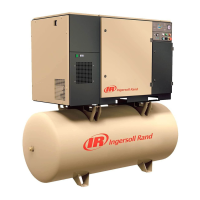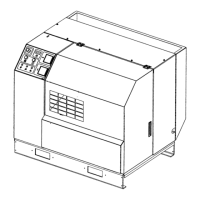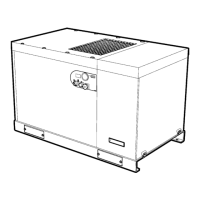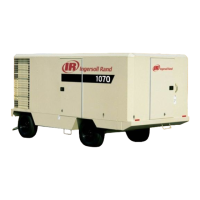8
1.0 RECEIPT OF EQUIPMENT
1.1 INSPECTION
When you receive the compressor please inspect it
closely.Any indication of careless handling by the car-
rier should be noted on the delivery receipt especially
if the compressor will not be immediately un-crated.
Obtaining the delivery man’s signed agreement to any
noted damages will facilitate any future insurance
claims.
1.2 UNPACKING AND HANDLING
The compressor package has been mounted on a
wooden shipping base which will allow fork lifting
under the compressor base to facilitate handling dur-
ing shipment. Care in positioning the forklift is impor-
tant because the location of the center of gravity is
strongly affected by the location of the airend and drive
motor.
The wooden base must be removed prior to installa-
tion.
2.0 INSTALLATION
2.1 VENTILATION
Air cooled air compressors produce large amounts of
heat. Because of this large heat production, the com-
pressor must be placed in a room with adequate venti-
lation.
If heated air from the compressor exhaust is allowed to
re-circulate back to the compressor, the compressor
will overheat and shut down.This heat must be
exhausted from the room.You should take this into
consideration when deciding where to place the com-
pressor within the building. Sufficient clearance must
be allowed around the compressor to perform the
required maintenance.
Ambient temperatures higher than 115°F (46°C)
should be avoided as well as areas of high humidi-
ty. Also consider the environment near the com-
pressor.
DUST, CHEMICALS, METAL FILINGS, PAINT FUMES,
and OVERSPRAY should be avoided as well as any
other conditions which might be detrimental to the
proper operation of the compressor.
2.2 FOUNDATION REQUIREMENTS
The compressor can be installed on any level floor that
is capable of supporting the weight.
When sound transmission is of particular importance,
it is often helpful to install a sheet of rubber-fabric-mat-
ting, under the compressor baseplate or receiver tank
feet to reduce the possibility of resonant sounds being
transmitted or amplified through the floor.
2.3 OUTDOOR INSTALLATIONS
When a compressor must be installed outside, there
are certain items that should be incorporated into the
installation to help assure trouble free operation.These
items have been listed below plus Figure 2.3-1 has
been included to show a typical outdoor protected
installation.The unit must be purchased with the
NEMA 4 option to provide watertight electrics, and a
TEFC motor.
• The compressor should be on a concrete pad
designed to drain water away.If the concrete pad is
sloped, then the compressor must be leveled.
• The roof of the shelter should overhang the compres-
sor a minimum of 4 feet (1.2m) on all sides to prevent
direct rain and snow from falling on the unit.
• The unit must be arranged under the shelter in a way
that prevents air recirculation (i.e. hot exhaust back to
the package inlet).
• If the installation includes more than one compressor,
the hot air exhaust should not be directed towards the
fresh air intake of the second unit or an Air Dryer.
• If a standard machine is to be installed outside, the
ambient temperature must never drop below 35°F
(2°C) or freezing of condensate will result.
• Power disconnect switch must be within the compres-
sor operator’s line of sight and should be in close prox-
imity to the unit.
• Condensate drains must never be allowed to dump
on the ground. Pipe to a suitable sump for future col-
lection, disposal or separation of lubricant and water
mixture.
• Incoming power connections must use suitable con-
nectors for outdoor weather tight service.
• Sufficient clearance must be allowed on all four sides
of the unit for service access. If possible, access by a
fork lift and/or an overhead beam hoist should be kept
in mind (for eventual service to airend or motor).

